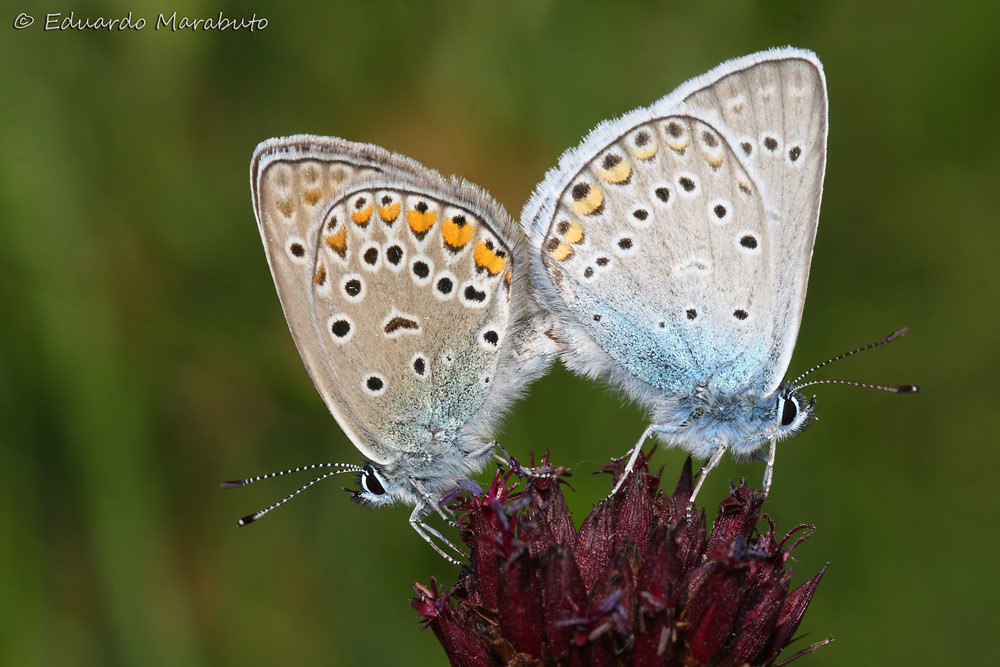 This is Lycaena bleusei (Lycaenidae, Lycaeninae), a small butterfly with an equally restrict distribution range in the centre of the Iberian Península.Here, it is to be found in and around the central mountain System from the spanish Sierra de Guadarrama westwards to the portuguese Serra da Estrela and Serra da Gardunha, with some populations to the south in nearby mountain ranges.
This is Lycaena bleusei (Lycaenidae, Lycaeninae), a small butterfly with an equally restrict distribution range in the centre of the Iberian Península.Here, it is to be found in and around the central mountain System from the spanish Sierra de Guadarrama westwards to the portuguese Serra da Estrela and Serra da Gardunha, with some populations to the south in nearby mountain ranges.This species in Portugal inhabits mountain pastures, forest edges and flowery meadows above 700-800m in the mountain system going from Serra da Malcata to Serra da Estrela and Gardunha although new colonies are expected to be discovered in the next years.
However, its distribution isn't exactly known due to the presence in the northern third of the country, of its sister species L. tityrus which is very similar and they were considered conspecific until very recently and we still don't know where ends tityrus and starts bleusei.
The caterpillars feed on docks (Rumex sp.) which are to be found in moist or wet conditions which are favoured by the butterfly too.
The other species of the genus in Portugal include the widespread and common L. phlaeas, the mountain species L. alciphron, the sister species L. tityrus to the north and the high mountain and very rare Lycaena virgaureae, in the extreme north of the country.
Picture taken in the Glacier Valley of the river Zêzere, Serra da Estrela, one of the strongholds of the species.
 ---
---
Esta é a Lycaena bleusei (Lycaenidae, Lycaeninae), uma pequena borboleta com uma igualmente restrita área de distribuição no centro da Península Ibérica.
Aqui poderá ser encontrada apenas no Sistema Central Ibérico e nas zonas em volta desde a espanhola Sierra de Guadarrama para oeste até à Serra da Estrela e Serra da Gardunha, com algumas populações a sul nos sistemas montanhosos próximos.
Em Portugal a L. bleusei habita pastos de montanha, orlas de florestas e prados floridos acima doa 700-800m no sistema montanhoso que vai desde a Serra da Malcata até à Serra da Estrela e Gardunha apesar de ser esperada a descoberta de novas colónias nos próximos anos.
Contudo, a sua distribuição não é muito bem conhecida devido à presença um pouco mais a norte de uma espécie gémea, a L. tityrus, muito similar e com os mesmo hábitos e ecologia tendo até muito recentmeente sido consideradas como pertencendo à mesma espécie e ainda não se sabe onde acaba a tityrus e começa bleusei.
As lagartas alimentam-se de azedas (Rumex sp.) que são normalmente encontradas em zonas húmidas, zonas também favorecidas por estas borboletas.
Outras espécies neste género incluem a comum e largamente distribuida L. phlaeas, a espécie de montanha L. alciphron, a supracitada L. tityrus para norte e a rara espécie de alta montanha Lycaena virgaureae, no extremo nordeste do país.
Fotografia tirada no Vale Glaciário do Rio Zêzere, Serra da Estrela, um dos locais onde a espécie é encontrada mais frequentemente.





 ---
---